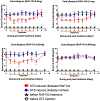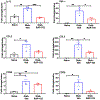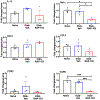Potentiation of morphine antinociception and inhibition of diabetic neuropathic pain by the multi-chemokine receptor antagonist peptide RAP-103
- PMID: 35817166
- PMCID: PMC9398950
- DOI: 10.1016/j.lfs.2022.120788
Potentiation of morphine antinociception and inhibition of diabetic neuropathic pain by the multi-chemokine receptor antagonist peptide RAP-103
Abstract
Aims: We determined the ability of the multi-chemokine receptor (CCR2/CCR5/CCR8) antagonist RAP-103 to modulate pain behaviors in an acute model of surgical pain, with and without an added opioid (morphine), and by itself in a chronic model of Streptozotocin (STZ)-induced diabetic peripheral neuropathy (DPN).
Materials and methods: Pain behaviors were assessed by mechanical and thermal tests in rats. Cytokine and chemokine biomarkers in sciatic nerve and spinal cord were assessed by in situ qPCR.
Key findings: In the incisional pain assay, RAP-103 (0.01-1 mg/kg, i.p.) alone had no antiallodynic effect post-surgery. RAP-103 (0.5 mg/kg) when co-administered with morphine (0.5-5 mg/kg), reduced the ED50 of morphine from 3.19 mg/kg to 1.42 mg/kg. In a DPN model, rats exhibited persistent mechanical and cold allodynia. Oral administration of RAP-103 (0.5-0.02 mg/kg/day) resulted in a complete reversal of established hypersensitivity in DPN rats (P < .001), which gradually returned to pain hypersensitivity after the cessation of the treatment. The mRNA expression of cytokines, IL-1β, TNFα; chemokines CCL2, CCL3; and chemokine receptors CCR2 and CCR5 in DPN rat sciatic nerve, but not spinal cord, were significantly increased. RAP-103 resulted in significant reductions in sciatic nerve expression of IL-1β, TNFα and CCL3 in STZ-induced diabetic rats with trends toward lower levels for CCL2 and CCR5, while CCR2 was unchanged.
Significance: In acute pain, co-administration of RAP-103 with morphine provided the same antinociceptive effect with a reduced dose of morphine, reducing opioid side-effects and risks. RAP-103 by itself is an effective non-opioid antinociceptive treatment for diabetic neuropathic pain.
Keywords: Antagonist; CCR5; Chemokine; Neuropathy; Opioid; Pain.
Copyright © 2022 The Authors. Published by Elsevier Inc. All rights reserved.
Conflict of interest statement
Declaration of competing interest
Dr. Ruff is an inventor of RAP-103 and has a financial interest in Creative Bio-Peptides, Inc. The funders had no role in the design of the study; in the collection, analyses, or interpretation of data; in the writing of the manuscript, or in the decision to publish the results.
Figures






Similar articles
-
Targeting Members of the Chemokine Family as a Novel Approach to Treating Neuropathic Pain.Molecules. 2023 Jul 30;28(15):5766. doi: 10.3390/molecules28155766. Molecules. 2023. PMID: 37570736 Free PMC article. Review.
-
A Missing Puzzle in Preclinical Studies-Are CCR2, CCR5, and Their Ligands' Roles Similar in Obesity-Induced Hypersensitivity and Diabetic Neuropathy?-Evidence from Rodent Models and Clinical Studies.Int J Mol Sci. 2024 Oct 21;25(20):11323. doi: 10.3390/ijms252011323. Int J Mol Sci. 2024. PMID: 39457105 Free PMC article. Review.
-
Bidirectional Action of Cenicriviroc, a CCR2/CCR5 Antagonist, Results in Alleviation of Pain-Related Behaviors and Potentiation of Opioid Analgesia in Rats With Peripheral Neuropathy.Front Immunol. 2020 Dec 21;11:615327. doi: 10.3389/fimmu.2020.615327. eCollection 2020. Front Immunol. 2020. PMID: 33408720 Free PMC article.
-
A New Application for Cenicriviroc, a Dual CCR2/CCR5 Antagonist, in the Treatment of Painful Diabetic Neuropathy in a Mouse Model.Int J Mol Sci. 2024 Jul 5;25(13):7410. doi: 10.3390/ijms25137410. Int J Mol Sci. 2024. PMID: 39000516 Free PMC article.
-
Involvement of Macrophage Inflammatory Protein-1 Family Members in the Development of Diabetic Neuropathy and Their Contribution to Effectiveness of Morphine.Front Immunol. 2018 Mar 12;9:494. doi: 10.3389/fimmu.2018.00494. eCollection 2018. Front Immunol. 2018. PMID: 29593735 Free PMC article.
Cited by
-
Identification of Immune Infiltration and the Potential Biomarkers in Diabetic Peripheral Neuropathy through Bioinformatics and Machine Learning Methods.Biomolecules. 2022 Dec 26;13(1):39. doi: 10.3390/biom13010039. Biomolecules. 2022. PMID: 36671424 Free PMC article.
-
Targeting Members of the Chemokine Family as a Novel Approach to Treating Neuropathic Pain.Molecules. 2023 Jul 30;28(15):5766. doi: 10.3390/molecules28155766. Molecules. 2023. PMID: 37570736 Free PMC article. Review.
-
A Missing Puzzle in Preclinical Studies-Are CCR2, CCR5, and Their Ligands' Roles Similar in Obesity-Induced Hypersensitivity and Diabetic Neuropathy?-Evidence from Rodent Models and Clinical Studies.Int J Mol Sci. 2024 Oct 21;25(20):11323. doi: 10.3390/ijms252011323. Int J Mol Sci. 2024. PMID: 39457105 Free PMC article. Review.
-
Diabetic Neuropathic Pain: Directions for Exploring Treatments.Biomedicines. 2024 Mar 6;12(3):589. doi: 10.3390/biomedicines12030589. Biomedicines. 2024. PMID: 38540203 Free PMC article. Review.
-
Blocking IL-17A prevents oxycodone-induced depression-like effects and elevation of IL-6 levels in the ventral tegmental area and reduces oxycodone-derived physical dependence in rats.Brain Behav Immun. 2024 Mar;117:100-111. doi: 10.1016/j.bbi.2024.01.001. Epub 2024 Jan 8. Brain Behav Immun. 2024. PMID: 38199516 Free PMC article.
References
-
- Kwiatkowski K, Pawlik K, Ciapala K, Piotrowska A, Makuch W, Mika J, Bidirectional action of cenicriviroc, a CCR2/CCR5 antagonist, results in alleviation of pain-related behaviors and potentiation of opioid analgesia in rats with peripheral neuropathy, Front. Immunol 11 (2020), 615327. - PMC - PubMed
-
- Padi S, Shi X, Zhao Y, Ruff M, Baichoo N, Pert C, et al., Attenuation of rodent neuropathic pain by an orally active peptide, RAP-103, which potently blocks CCR2- and CCR5-mediated monocyte chemotaxis and inflammation, Pain 153 (2012) 95–106. - PubMed
-
- Zychowska M, Rojewska E, Piotrowska A, Kreiner G, Nalepa I, Mika J, Spinal CCL1/CCR8 signaling interplay as a potential therapeutic target - evidence from a mouse diabetic neuropathy model, Int. Immunopharmacol 52 (2017) 261–271. - PubMed
MeSH terms
Substances
Grants and funding
LinkOut - more resources
Full Text Sources
Other Literature Sources
Medical

